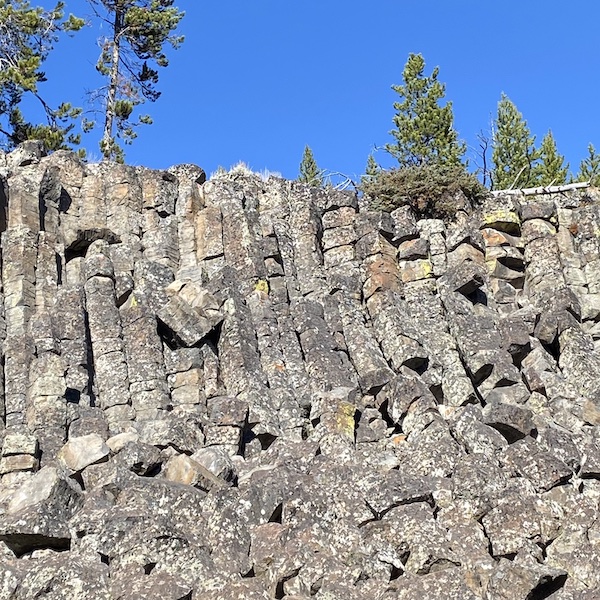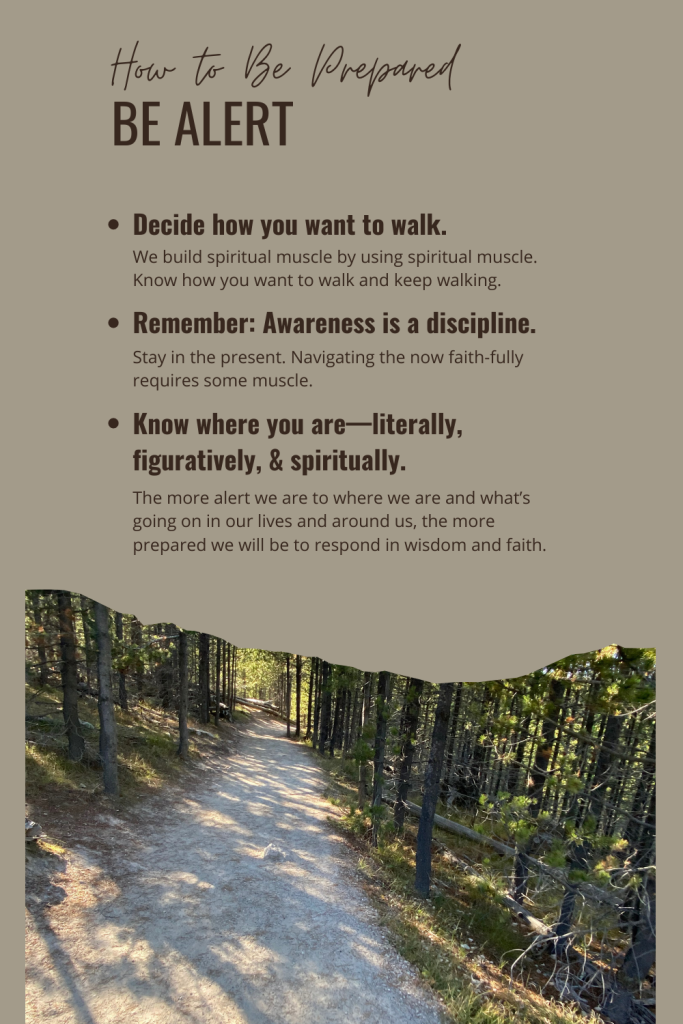Crossing the gravel parking lot, Dad and I turned toward the Gardner River. Worn by wildlife and fly fishermen, the narrow path that paralleled it wasn’t an official trail. We knew it only because of the hours three generations of our family had collected here at Sheepeater Cliff Picnic Area, lunching and exploring near the base. Basalt, the volcanic rock that formed the cliff, breaks vertically into neat columns and horizontally into blocks. Over time, these fractures formed a rugged wilderness staircase that my mountain goat-y children and husband like to scramble up.

Dad and I hadn’t gone far down the trail before it turned, revealing a second bank of columnar basalt. Stretching as far as I could see, it dwarfed the one we’d left behind at the picnic area. I stopped and stared. Standing there, I tried to take in its immensity. At the same time, I tried to understand how it was that I’d been down this trail twice before yet had no memory of this place.
I believe in the importance of attention. There’s something to see—and not just in places like Yellowstone. There’s something to see in our own backyards and our everyday lives. How then, did I miss this Great Wall in the wilderness? I knew the answer, and it troubled me: autopilot is easy and attention is hard.
This is why, when I read the new bear-aware sign in Yellowstone asking me if I was prepared to avoid an attack, I knew that I was not—not on the trail and not in life.
The first directive on the ominous yet oddly comforting BEAR ATTACK: Are you prepared to avoid one? sign (read part 1 here) was this: Be Alert. It seems simple enough, yet, clearly, this is something of a struggle. Of the five, it’s the hardest for me to do. Scenery, boredom, and fatigue all conspire to call my attention away from watching for bears on the trail, as well as signs that they may be nearby. (So you know, bear signs include fresh tracks, scat, or claw marks on trees, newly torn up logs or digging sites, and carcasses—buried or out in the open.) Bears are wild creatures, making this level of autopilot a risk hikers can’t afford.
It’s true on the trail and it’s true in life.
We have an enemy. He’s on the prowl, and to save us from becoming prey God tells us to be sober-minded and watchful. In other words, alert. Perhaps you’re like me, and alert is not your natural state. Perhaps you, too, are prone to distraction and drift. Perhaps you sense the threat these two pose to our ability to be prepared to navigate everyday life by faith.
In Yellowstone, bears can be anywhere, anytime, but not everywhere all the time. We don’t know when we’ll see one or where, so we need to watch so that when we encounter them, we’ll be prepared and ready to respond appropriately. In life, it is much the same. If we want to be prepared—to navigate the ups and downs of daily life by faith rather than by fear, feel, or anything else, we need to walk with our eyes open–aware.
To that end, here are three things to keep in mind:
- Decide how you want to walk. By faith? Fear? Autopilot? Something else? Just as we build physical muscle by using physical muscle, we build spiritual muscle by using spiritual muscle. Know how you want to walk and keep walking.
- Remember that awareness is a discipline. Alertness comes more naturally when mind and body occupy the same space. Practice living in the present. Racing into the future and lingering in the past are easy. Autopilot is easy. Navigating the current moment faith-fully requires some muscle.
- Pay attention to where you are—literally, figuratively, and spiritually. We’re in lion territory. Trials and momentary difficulties pop up when we least expect them. As Russell Moore said, “In many ways, the more tranquil you feel, the more endangered you are.” The more alert we are to where we are and what’s going on in our lives and around us, the more prepared we will be to respond in wisdom and faith.
I’ve put together a 5-scripture printable to accompany the Bear Attack! Are you prepared to avoid one? series. You can access it (and a few other things!) here.
🧭 When it comes to navigating the landscape of your life by faith, what’s your biggest challenge–distraction, fear, or something else? What do you do to course correct when you start to drift?
take heart & happy trails ~ Natalie 🥾
This is the second in a series Bear Attack: Are You Prepared to Avoid One? Read part one here.
I usually link with the writers at
Let’s Have Coffee,Tell His Story,
Inspire Me Monday, and Grace & Truth.
Are you an armchair traveler? Would you love to learn what hiking Yellowstone's trails teaches about walking by faith in everyday life?
Get a photo journal (with excerpts!) from Natalie’s October 2022 Yellowstone adventure.
Keep tabs on Natalie’s Yellowstone memoir-in-progress and receive Lessons from Yellowstone to help you navigate the ups and downs of daily life by faith.

This is a very poignant message with a wonderful lesson within.
visiting today from Let’s Have Coffee #15
Yellowstone has a lot of lessons to teach.
Natalie, such a great post! You’re so right, we need to live aware if we are to be prepared for the enemy’s attack. I could tell you a couple of stories that involve mountain lions…sometimes they’re so quiet you don’t realize how close they are. The enemy will seek to get that close to us too. Listening and being alert make all the difference, don’t they?
I had a pastor once who said that one of the great tragedies of the Christian life is that we don’t remember how lions hunt. Experience with nature helps us understand the metaphors God created. (And thanks for your kind words.)
Hi Natalie,
It seems the lions are everywhere. If we aren’t alert, we won’t be effective and easily wounded. Great post!
(I grew up in Montana and visited Yellowstone regularly. It’s so beautiful.)
Blessings,
Tammy
P.S. Thanks for linking up with G&T.
I lived and worked for a time in Yellowstone and completely agree–it is beautiful! It’s been a good teacher in the school of what it means to walk by faith in everyday life. Thanks for your kind words and for stopping by.
Great post Natalie!
I came out of hypervigilence which is the opposite to autopilot after having many traumatic events one after the other in my life…a few are the deaths of two of my children & then the death of my late husband to brain cancer…then chronic health conditions hit me & hit hard.
I was hyper alert waiting for the next blow to hit from left field…but I have come to realise that no matter what may come, Jesus has never left me & walks with me (often carrying me) through any & every circumstance that may come my way.
So I now rest in Him & allow the Holy Spirit to be my guide, comforter & protector. So yes I am prepared for He is prepared. 🙂
Blessings, Jennifer
“I am prepared for he is prepared.” That’s the biggest thing, isn’t it? Hypervigilance seems like a typical response to the hard road you have walked. I’m so glad you’ve found freedom from that.
Great lesson Natalie! Awareness is a discipline, and too often I feel like I bumble my way through my days and wonder why I get “lost” or worse! Yet I don’t hike without awareness!
The skills don’t always automatically transfer, but time on the trail helps me bring what I learn from hiking into my life.
Your picture is amazing as I’ve never seen volcanic rock like this before, Natalie. Great application from natural awareness to spiritual awareness.
nice comparison.
I need to work on awareness
YOu’re not a lone. I need constant reminders to do so, too.
You have great advice for natural hiking awareness and for spiritual attentiveness, Natalie!
Thank you! It’s amazing how much we can learn about walking by faith from walking in the woods.